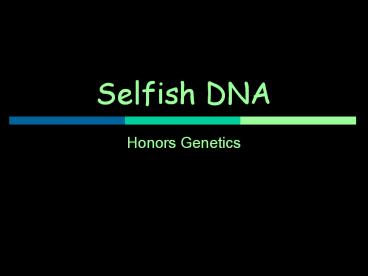Selfish DNA - PowerPoint PPT Presentation
1 / 30
Title:
Selfish DNA
Description:
Genes are viewed as 'ORFS' Open Reading Frames These are ... of extant humans and are therefore observed in all individuals in the human population. ... – PowerPoint PPT presentation
Number of Views:822
Avg rating:3.0/5.0
Title: Selfish DNA
1
Selfish DNA
- Honors Genetics
2
DNA Genes and the Rest
- Genic ( Gene containing portion of DNA) -
- Genes are viewed as ORFS Open Reading Frames
These are determined by a start - 3 TAC and a stop ATT5
- Genes account for 25 of our DNA
- In a gene there are coding regions
- Exons
- Between the Exons there are intervening sequences
called Introns
3
What is the product of a Gene ?
- Proteins All types such as transmembrane
proteins , transport proteins, immune proteins,
messenger proteins, enzymes, channels, toxins,
developmental proteins - ( hox), transcription factors, and many more
- RNAs m RNA ( intermediate in protein
synthesis), t RNA required for protein synthesis,
r RNA( ribosomal RNAs), RNAi, antisense RNAs,
micro RNAs, snurps, spliceosome RNAs and many more
4
ORF
5
What is a Gene?
6
Gene Expression
7
Spliceosome editing the primary transcript
8
Intron Borders
9
DNA to Protein
- Only 1 of DNA actually defines the structure of
genes and proteins - Out of 46 chromosomes containing 30,00-50,000
genes only 1 is actively engaged in keeping you
alive
10
Making a Protein
- http//www.johnkyrk.com/DNAtranslation.html
11
Genes are grouped in islands on chromosomes
- Genes are in clusters on chromosomes
- What is between the space between the genes
contains DNA that has survived through evolution - It is believed to be the substance of mutations
contributing to change in the change for both the
positive and negative
12
Genes were thought to be fixed in one location on
a chromosome
- 17q31.2
13
Barbara McClintock discovered jumping genes
- Jumping genes are referred to as mobile
- They have the ability to change their position
and jump from one chromosome to another - Jumping genes are also called TRANSPOSONS
14
The Original Jumping Genes
15
Transposons
- 1) IS - insertion sequence. Inverted repeats
transposase gene - 2) Composite transposon. Two IS elements
antibiotic resistance gene(s) - 3) Noncomposite transposon. Inverted repeats
transposase gene antibiotic resistance gene(s)
16
Transposon Action
17
Transposon structure
18
Transposable elements and the new meaning of
mutation
19
Retrotransposons
- Retrotransposons move by a "copy and paste"
mechanism but in contrast to the transposons
described above, the copy is made of RNA, not
DNA. - The RNA copies are then transcribed back into DNA
using a reverse transcriptase and these are
inserted into new locations in the genome. - Many retrotransposons have long terminal repeats
(LTRs) at their ends that may contain over 1000
base pairs in each. - Like DNA transposons, retrotransposons generate
direct repeats at their new sites of insertion.
In fact, it is the presence of these direct
repeats that often is the clue that the
intervening stretch of DNA arrived there by
retrotransposition. About 40 of the entire human
genome consists of retrotransposons.
20
Sines ( Short Interspersed elements)
- SINEs are short DNA sequences (100400 base
pairs) that represent reverse-transcribed RNA - Alus - Thousands of our Alu elements occur in the
introns of structural genes.
21
(No Transcript)
22
Alu Action
- ALU elements have been accumulating in the human
genome throughout primate evolution, reaching a
copy number of over a million per genome.
However, most of these Alu copies are not
identical and can be classified into several
subfamilies (reviewed in DEININGER and BATZER
1993 ). - These different subfamilies of Alu elements were
generated once mutations occurred within the
"master" or "source" gene that actively
retroposed at different rates and time periods of
primate evolution (DEININGER et al. 1992 ). - Currently, the Alu retroposition rate is reduced
by 100-fold from its peak early in primate
evolution (SHEN et al. 1991 ). The vast majority
of the Alu elements present in the human genome
inserted before the radiation of extant humans
and are therefore observed in all individuals in
the human population.
23
Microsatellites
- Studies show that microsatellites, tandem repeat
sequences abundant in the genomes of higher
eukaryotes, contain reiterating A-rich loci,
which are involved in the higher-order
organization of the chromatin - Other studies have shown satellites consisting of
about 1 million copies of a 221-bp tandem repeat
unit has been localized in the centromeres of 58
of the 64 horse chromosomes - Many hundreds of studies have implicated
mutations in satellites, minisatellites, and
microsatellites, in diseases which show genetic
linkage, including studies on Crohn's disease
24
What is Selfish DNA?
- The theory that we creatures exist for the
preservation of genes and are nothing more than
their throwaway survival machines. - Natural selection means the differential survival
of the fittest - Does natural selection choose the most fit
individuals or the most fit genes?
25
What are the characteristics of Selfish DNA?
- They have been called "junk" DNA and "selfish"
DNA. - "selfish" because their only function seems to
make more copies of themselves and - "junk" because there is no obvious benefit to
their host.
26
Some theories on Alus
- Some of these contain sequences that when
transcribed into the primary transcript are
recognized by the spliceosome. - These can then be spliced into the mature mRNA
creating a - new exon, which will be transcribed into a new
protein product. - Alternative splicing can provide not only the new
mRNA (and thus protein) but also the old. - In this way, nature can try out new proteins
without the risk of abandoning the tried-and-true
old one.
27
Alternative splicing
- http//www.exonhit.com/UserFiles/Image/epissage.sw
f?PHPSESSIDotrsjha8drtbpuah7knuu4c394 - http//www.exonhit.com/index.php?page59
28
Alternative Splicing
29
(No Transcript)
30
(No Transcript)

